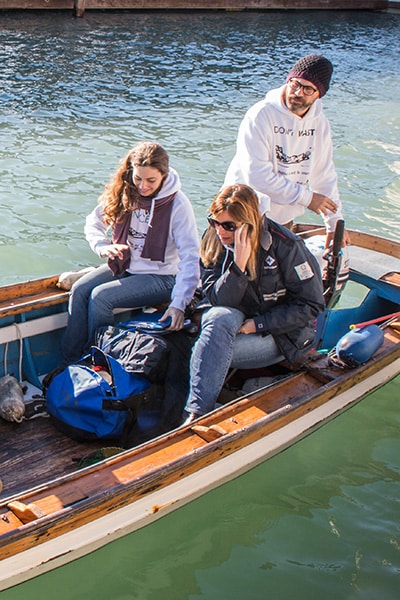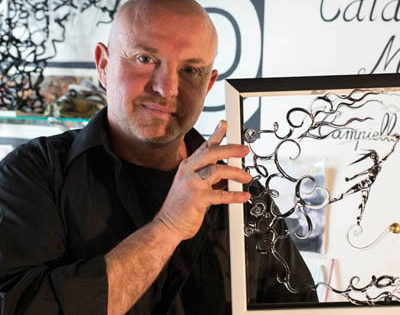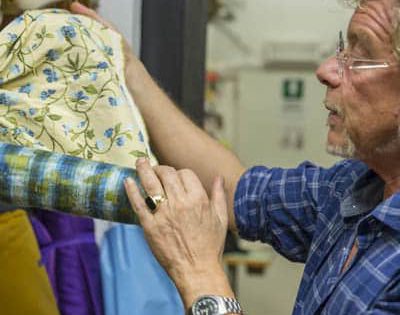Piero Dri, Artisan Remer
https://veneziaautentica.com/wp-content/uploads/2016/01/piero-dri-artisan-remer-2.jpg 900 900 Venezia Autentica | Discover and Support the Authentic Venice Venezia Autentica | Discover and Support the Authentic Venice https://veneziaautentica.com/wp-content/uploads/2016/01/piero-dri-artisan-remer-2.jpg
Piero Dri , artisan Remer
An ancient craft bond to Venice like few others, oar, and oarlock making officially dates back to 1307 CE. Four people in the whole world retain the knowledge of this centuries-old profession, and Piero is the youngest of them.
Techniques
Piero makes use of the traditional tools and techniques of the oar and oarlock makers, the “remeri”, to handcraft his unique pieces: every oar and every oarlock is precisely tailored according to both the final user and the boat it will be used on.
With expertise and dedication, Piero creates unique oars and oarlocks, as well as original accessories and pieces for your home, all made of walnut wood.
Philosophy
The oarlocks are extremely beautiful and therefore extremely appreciated also as interior decoration but, as a “remer”, Piero always crafts his pieces keeping in mind and respecting the nature of the oarlocks as an extremely functional rowing pivot.
Graduated as a talented astronomer, Piero decided to set his degree aside and invest his efforts and dedication into the art of the “remeri“, in order to reinforce his strong bond to Venice and its Lagoon that he inherited from his grandfather.
I hope that everybody, both those who were born here and those who decided to move here, will join together and find the way to do good to Venice
Hello, I’m Piero Dri. I’m Venetian and I’m a “Remer”: a oars [remi] and oarlocks [forcole] maker. It’s one of the most ancient crafts in Venice.
The “forcola” is the Venetian term for oarlocks, the strut of the oar that is used for rowing. There are different types of “forcole”, for every type of Venetian boat: so I do not do them only for the gondolas, but for every type of Venetian boats. They (the forcole) are all tailored from one whole piece of walnut wood. It’s been a bit a re-connection with a part of me, which is connected to rowing and a way of living Venice “slow” if we want to use a modern way to say it. This old passion of mine, which I inherited from my grandfather who used to bring me around on his “sandolo” [a type of Venetian boat], gave birth to the desire to reconnect with this aspect of the Venetian world.
I practice the traditional techniques, which I learned from my master Paolo Brandolisio in his workshop, which has previously been run by Giuseppe Carli. All the methods, the instruments, and the techniques are those that were in use already one century ago.
It begins with a pretty big trunk, of a diameter of around 60 cm, that has then to be cut in 4 pieces, let’s say slices, big enough to be able to carve in each quarter a “forcola” for a gondola, which is the thickest kind of “forcola” that can be made. These quarters will be left seasoning and, once ready, they will be sawn accordingly to the size of the “forcola”. So every rower, based on his height, will have a longer or shorter “forcola”. The work is tailored using this bucksaw which is a very old kind of saw, very practical for narrow curves and then, the final touch is done using this tool, which is a sort of a two handed scalpel, called draw-knife, which come in different sizes, based on the shape of the surface we need to work on: the broader one for surfaces without curves, while if I have to work here [indicating a point on the forcola] or on the “morso” [fulcrum], which has to be done perfectly for rowing, I use a smaller tool and continue this way. So, these are my working tools, they are not many, they are also pretty simple, but they give you the ability to do many things. Actually, these tools are not found for sale, so one problem of this artisanal craft is that we need ourselves other artisans that craft us our working tools and are disappearing. From this point of view, it is all connected to each other.
This shape is not just for creating a beautiful object to look at, but is also extremely functional: every curve of the “forcola” gives the ability to perform a number of movements. For example, this part here called “recia” [in venetian] or “orecchio” (“ear”), is used for braking the boat. Especially versatile is the “forcola” for the gondola, for it offers a reverse gear position, one for rowing in narrow canals and to
maneuver the boat in the most efficient way. Basically, the shape is a synonym of functionality.
It’s a place with plenty of stimulations, where it’s possible to lead a serene life and with many beautiful things, especially from a naturistic point of view both because of its geographical position and its urban structure and also purely for the social aspect: the fact that the city is so small, leads to always encounter many people and have therefore a rich social life.
It could be the right place where to experiment a model for a city of the future It could be the place where to find a union between antique and modern. With modern I mean an intelligent use of the resources that we now have, that we could use with moderation and combine them with a simple life style.
Yes, it changes, because the aforementioned social aspect is pauperising. Stores are closing, those stores essential to living, while absolutely pointless shops are opening. But I wish, and I am already seeing a small change, that there will be an upturn, that us people, also those who were not born in Venice, because now there are plenty who moved in and love Venice maybe more than many of us, will all together find a way to build something good.
I remember especially the first “forcola” I made here, which was important to me, because from my master’s workshop I moved here with new tools and it wasn’t easy at first. I was used to work with his tools, so the first “forcola” I crafted here, with all the challenges I had to face, made me especially proud and I feel attached to that one in particular.
In general the tourist, but not only the tourist, likes the “forcola” as a sculpture, appreciating the aesthetical value of it in the first place. But then it is always nice that besides the appearance, there is a reason behind those lines.
I’m happy with my venetian customers because this year I had many gondolieri appreciating my oars so let’s say that his year [2015] was the year of the oars, but I receive good feedback also with the oarlocks <> so I do get satisfaction, I am really happy with the response so I hope it will continue like this, that I won’t do something stupid [laughing] in the future
The way I suggest you to visit Venice, is to try and live the city the way the authentic venetians live and appreciate it, therefore discovering those areas that are slightly more hidden, avoiding the mass tourism places, getting away from the main streets. Go and explore the more silent areas, which in my personal opinion are the best ones, those that will make you appreciate the intact Venice, and help you find a more human and quiet dimension of a peaceful life.
I'm visiting Venice. Why should I follow your recommendations?
The way you visit Venice has an impact both on the quality of your experience and on Venice itself. Chilling, exploring, shopping, eating and drinking where the locals do, can make a huge impact both on the memories you bring home and on the local economy and community.
Home >> Venice & Venetians >> Portraits of Venetians >> You’re Here
Video Interviews of Venetians
More about life in Venice, Italy
Shop Made in Venice







